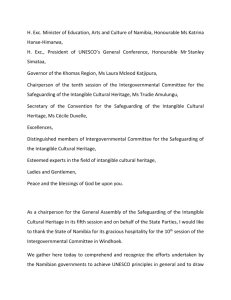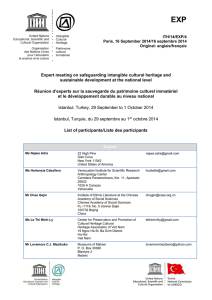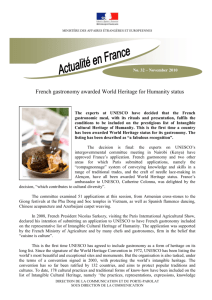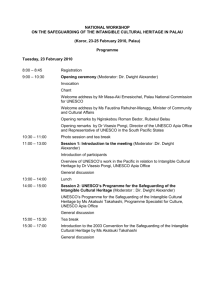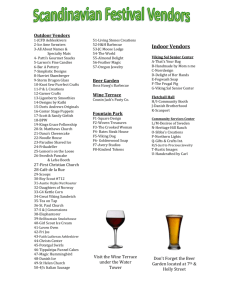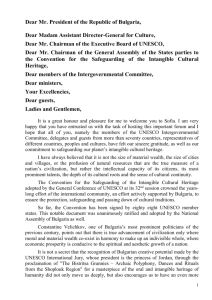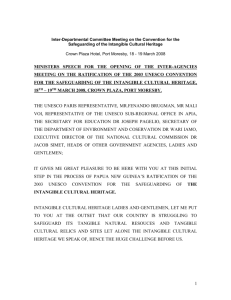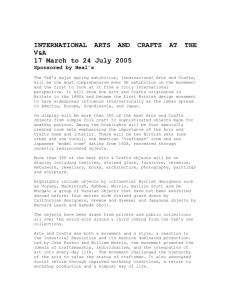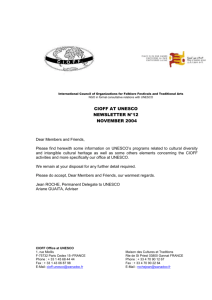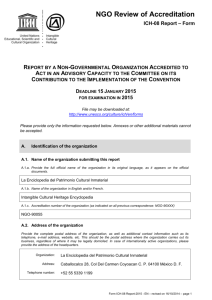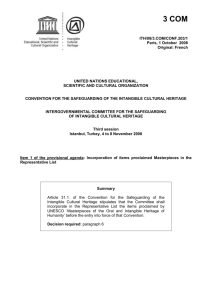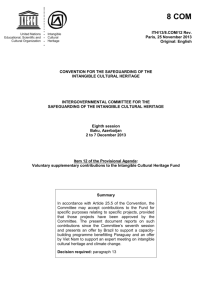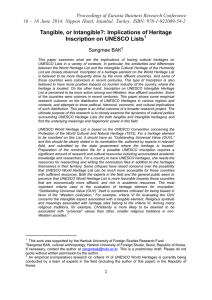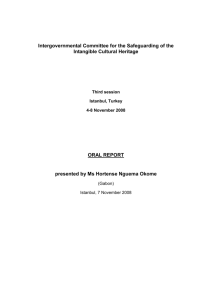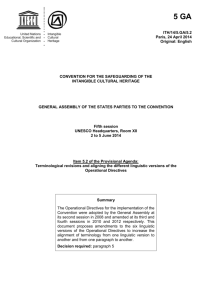ESRB / AHRB Cultural Industries Seminar Network
advertisement
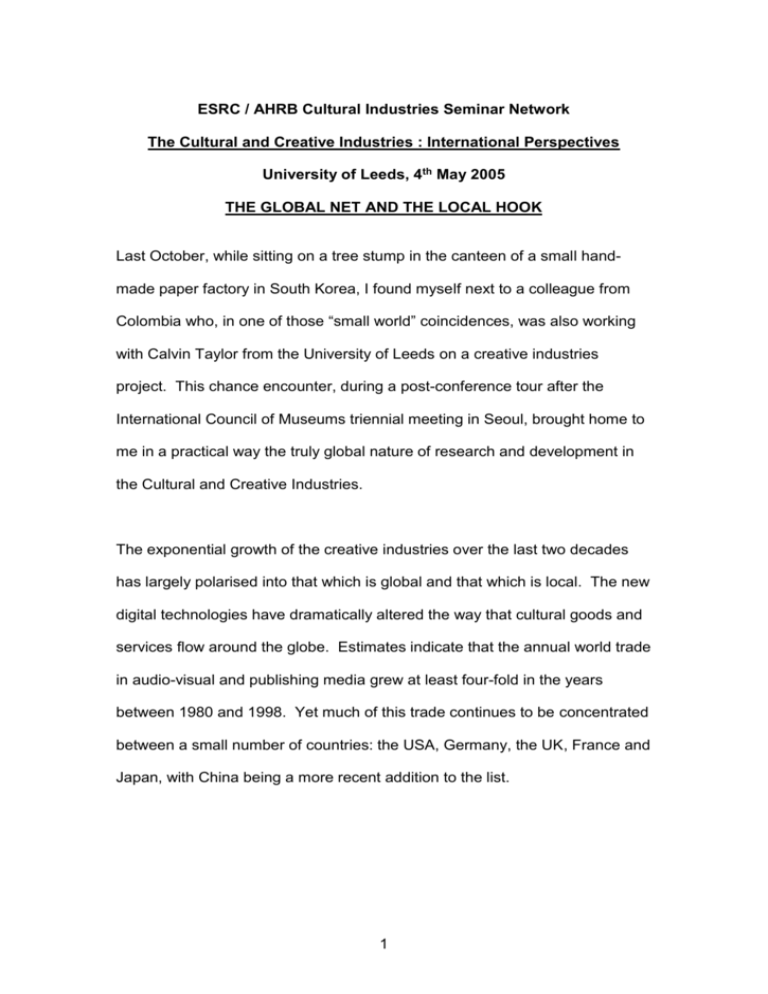
ESRC / AHRB Cultural Industries Seminar Network The Cultural and Creative Industries : International Perspectives University of Leeds, 4th May 2005 THE GLOBAL NET AND THE LOCAL HOOK Last October, while sitting on a tree stump in the canteen of a small handmade paper factory in South Korea, I found myself next to a colleague from Colombia who, in one of those “small world” coincidences, was also working with Calvin Taylor from the University of Leeds on a creative industries project. This chance encounter, during a post-conference tour after the International Council of Museums triennial meeting in Seoul, brought home to me in a practical way the truly global nature of research and development in the Cultural and Creative Industries. The exponential growth of the creative industries over the last two decades has largely polarised into that which is global and that which is local. The new digital technologies have dramatically altered the way that cultural goods and services flow around the globe. Estimates indicate that the annual world trade in audio-visual and publishing media grew at least four-fold in the years between 1980 and 1998. Yet much of this trade continues to be concentrated between a small number of countries: the USA, Germany, the UK, France and Japan, with China being a more recent addition to the list. 1 The full globalisation of the digital creative industries still remains an illusion as the growing gap between the developed world and the developing world continues to grow. It is easy to forget that basic necessities have to be met before IT strategies can be developed. As an example, while travelling in Georgia last summer on a fact-finding mission it became evident to me that any serious consideration of computerisation policy would have to be postponed as few, if any, of the regional museums we visited could even afford to pay for their electricity supply. So, much remains to be done to develop the digital creative industries into a truly global net and this can only be achieved through a range of innovative new partnerships, capacity-building and tighter piracy control. At the other end of the cultural and creative industries spectrum, that which is truly local and distinctive has more immediate prospects of successful development around the world, despite the ever-onward march of Coca-Cola and MacDonald’s. Traditional arts and crafts, intangible heritage such as dance and ritual, as well as tangible cultural heritage goods, stand to benefit from two factors. Firstly, the seemingly unstoppable growth in tourism, now increasingly fuelled by a desire for “the authentic” and, secondly, the growing realisation that both the tangible and intangible heritage needs to be preserved in a fast-changing world. Preservation of traditional cultural and craft activity skills remains very variable across the world. Some countries have ratified the UNESCO Convention on the Protection of Intangible Heritage. These include Korea and Japan, where 2 systems of designating pre-eminent craftspeople and exponents of the performing arts as “Living Human Treasures” or “Living National Treasures” have been implemented. However, such systems are not without their problems. Who is sufficiently informed to designate? Should any change or evolution in style be allowed between generations? In Korea there is an imbalance between music and dance for example, due to less research having been carried out on the latter, and only a single individual can ever be designated in any field of activity. What happens to the rest? Some other countries such as Uzbekistan accord their craftspeople a formal title of Master Craftsman to reflect a high level of skill in crafts such as woodcarving, while other nations have no formal intervention and allow market forces to determine both quality and form. This leads to a variety of outcomes ranging from the contemporary flowering of almost-forgotten arts and crafts to the development of new types of goods using old techniques such as, for example, the non-traditional pencil-cases made of woven carpet in Azerbaijan to suit tourists’ needs. However, market forces alone can often lead to the production of debased cultural products such as “airport art”. These are frequently accompanied by a loss of skills and, additionally, the loss of value-added to the local economy if multi-national commercial interests also intrude. To suit the air traveller’s needs traditional objects may be shrunk in size, change their shape, or focus on the sensational “other”, as in the case of the over-sized cannibal forks being produced in Fiji as tourist souvenirs. 3 In many instances, state intervention at a national, regional or local level could do much to maintain and raise quality standards through policy initiatives, education, training and provision of access to world markets. For it is the interface between the global and the local that is frequently missing in developing and transitional economies. Better strategies need to be put in place to link the producers and consumers of cultural and creative industries be they of CD-Roms, festivals or embroidered textiles. In the 21st century such strategies may well need to be supranational to give access to new audiences and markets and enable global distribution. Paradoxically, the greater the reach of the global net, the more vital it is that the local hook of cultural diversity is maintained and developed. For its 2004-2005 Cultural Programme, as well as its Strategic Objectives for the period 2002 – 2007 UNESCO has identified cultural diversity as its foremost priority. Set within that cultural diversity framework, the cultural and creative industries are seen as a key component of sustainable development and the eradication of extreme poverty, both through arts, crafts and design, and cultural tourism. Member states will be assisted in the field of innovative cultural policy design and its integration into development strategies. Sectoral cultural policies, especially in relation to cultural industries, crafts and design will also be developed and capacity-building support will be offered for sustainable development in these fields. A special initiative for the period 2002 – 2007 called “The Global Alliance for Cultural Diversity” has been 4 established as a UNESCO partnership between the public, private and civil society sectors to implement projects that strengthen local cultural industries and encourage respect for copyright and neighbouring rights. The linking of creative industries so strongly to cultural diversity presents an excellent opportunity to integrate the issues of identity, creativity and economy, to the potential benefit of all three. Today’s seminar will consider both the common and the distinctive elements of developing cultural and creative industries in different parts of the world and what lessons may be learned to stimulate policy innovation both in the UK and in the international arena. The importance of this goal is reflected in the following quotation taken from UNESCO’s website : “Culture will surely become the driver of the economy in the XXIst century. Cultural diversity constitutes a global asset that the international community must capitalise on, not only for economic, but also for ethical reasons as a matter of fairness and justice. There is nothing dearer to the human being than culture. Nothing requires more urgent attention than making culture the central axis of global as well as sustainable development”. 5
